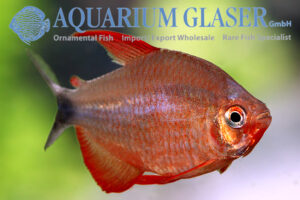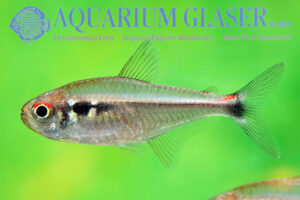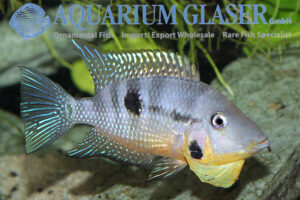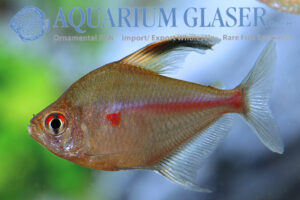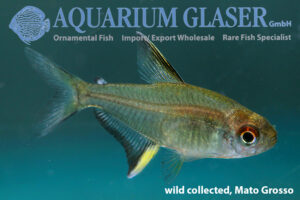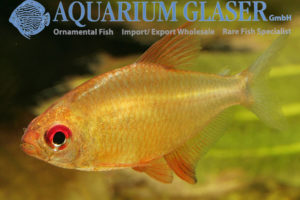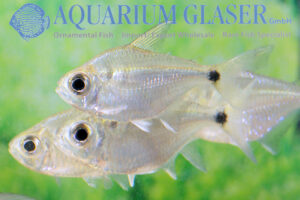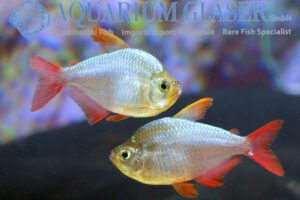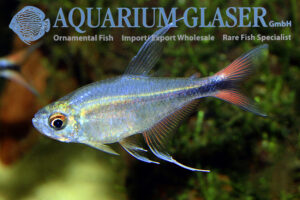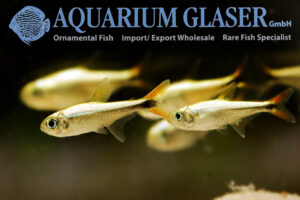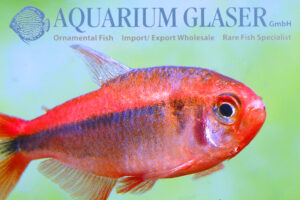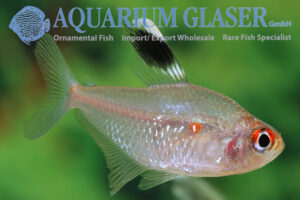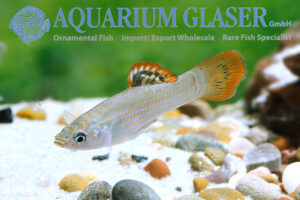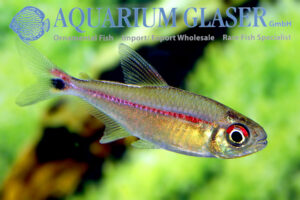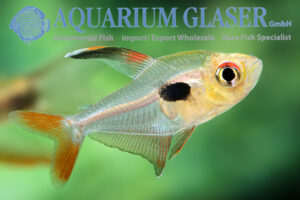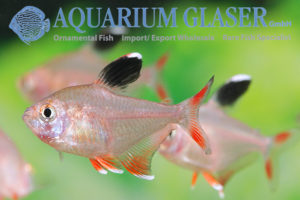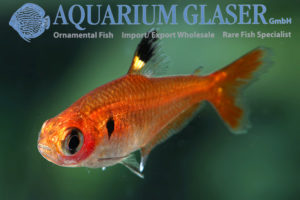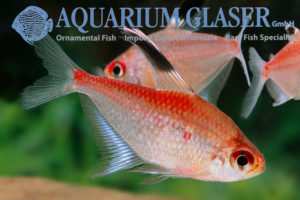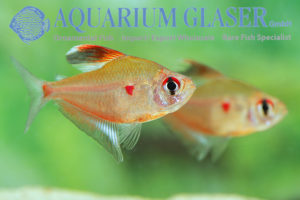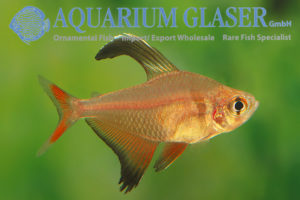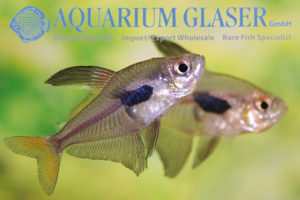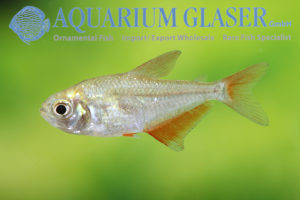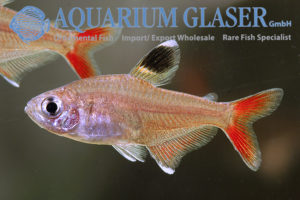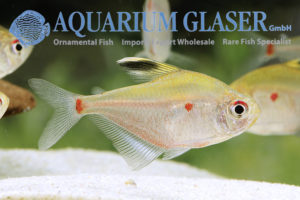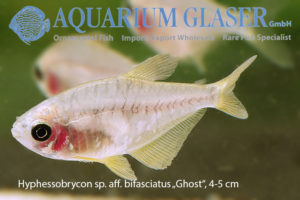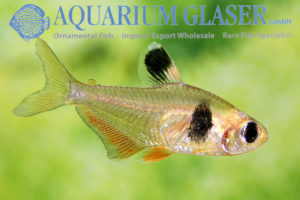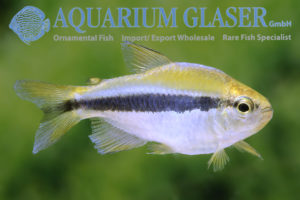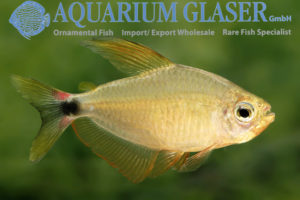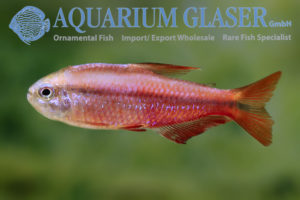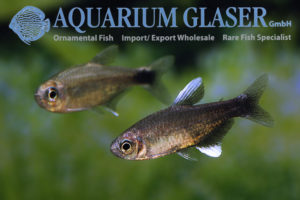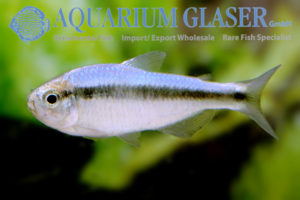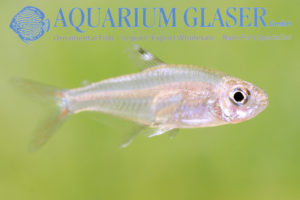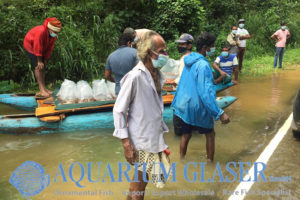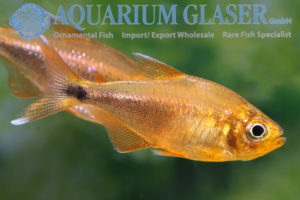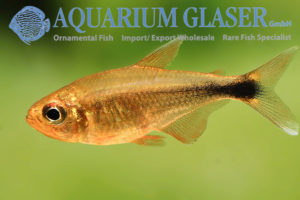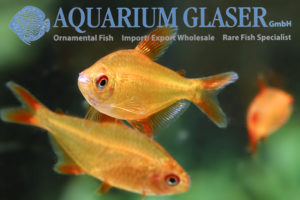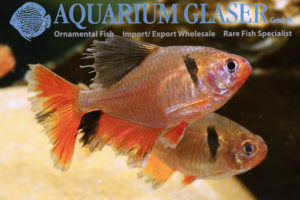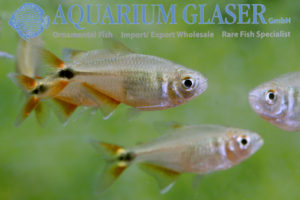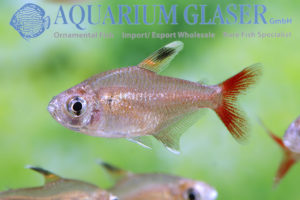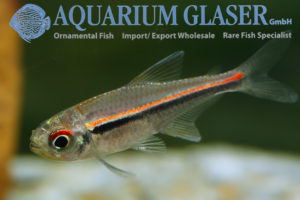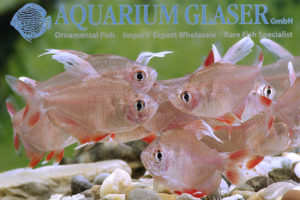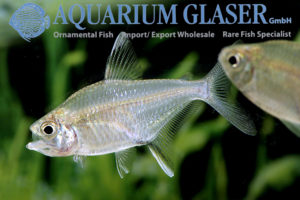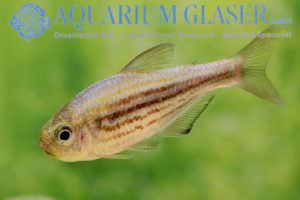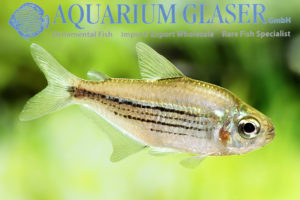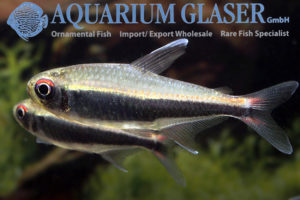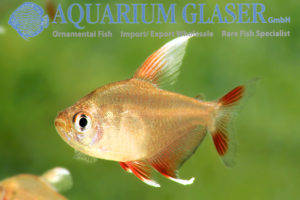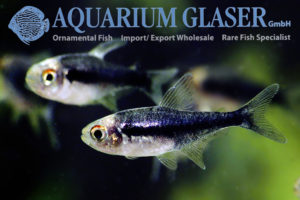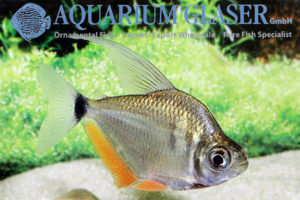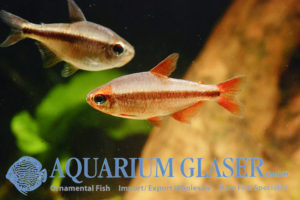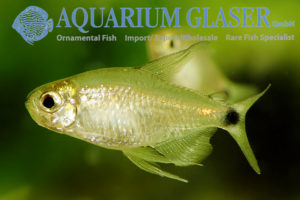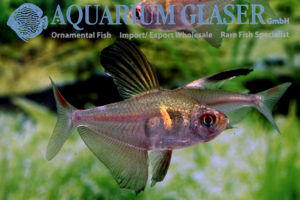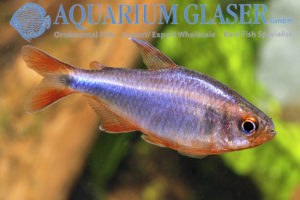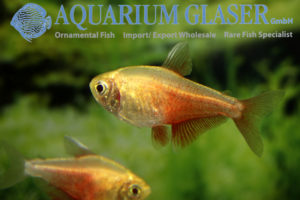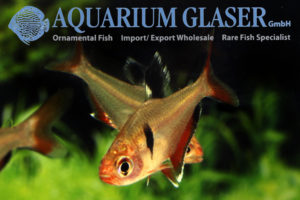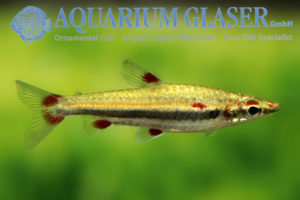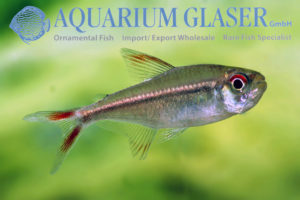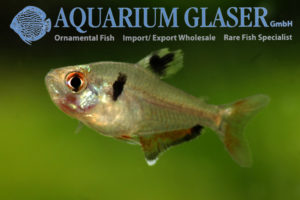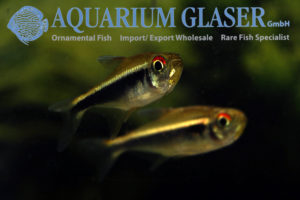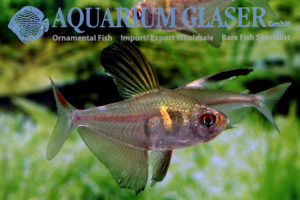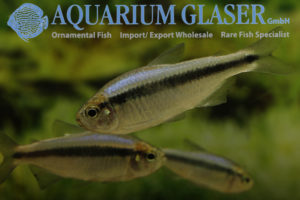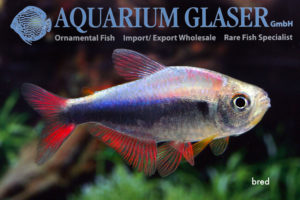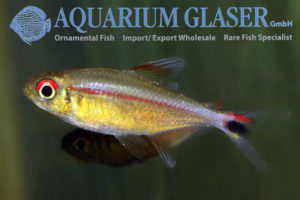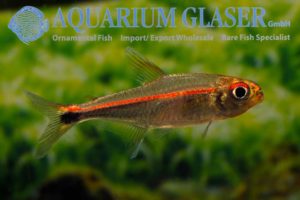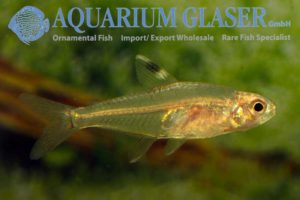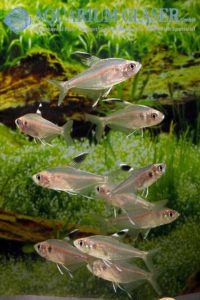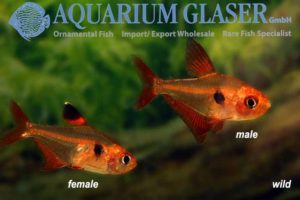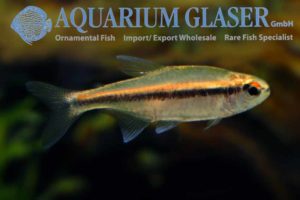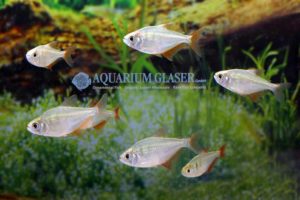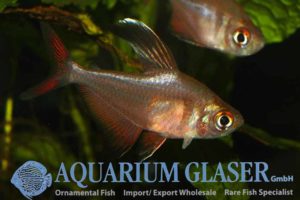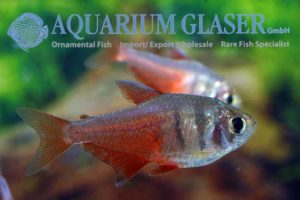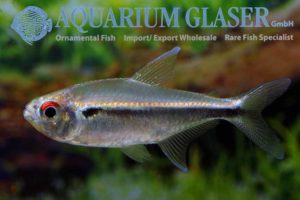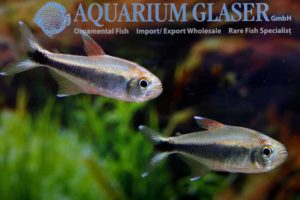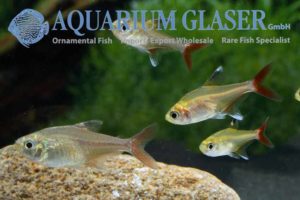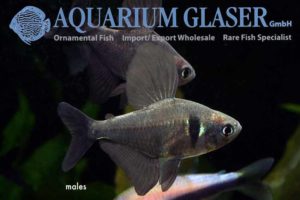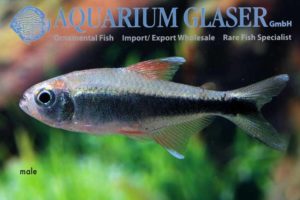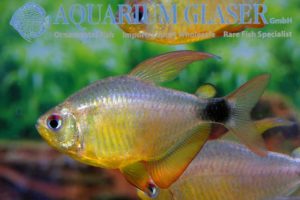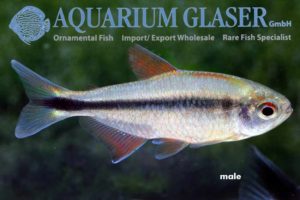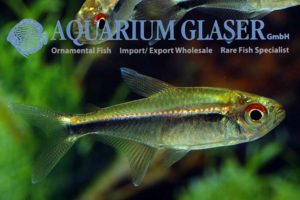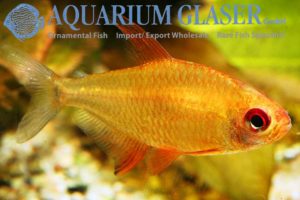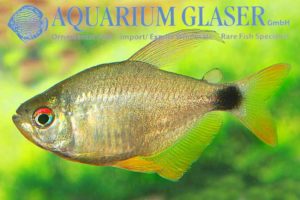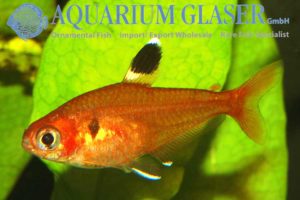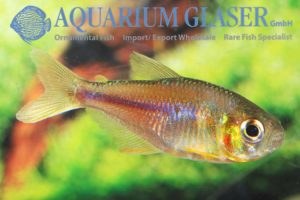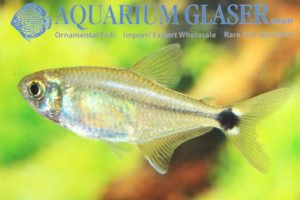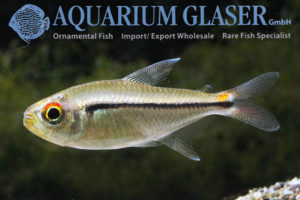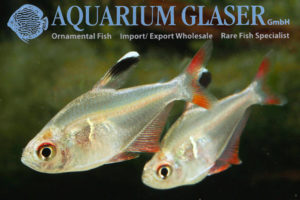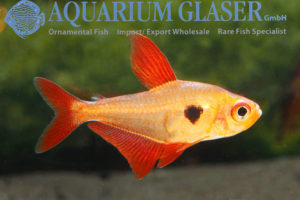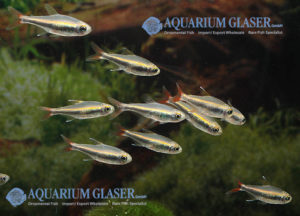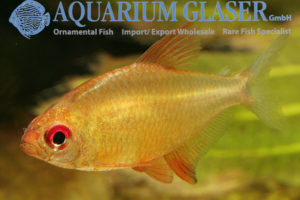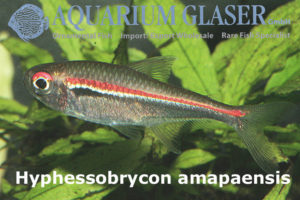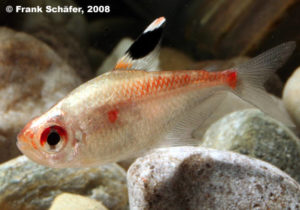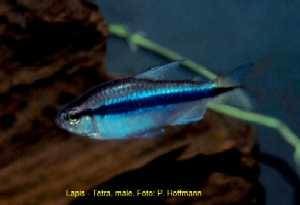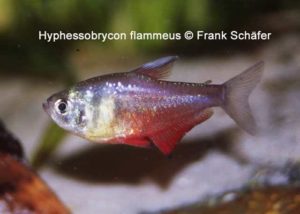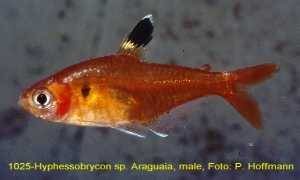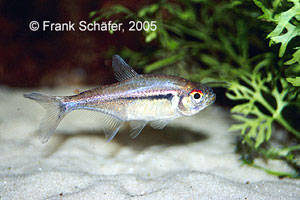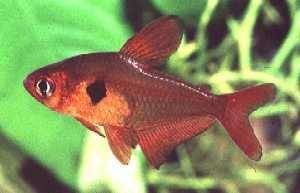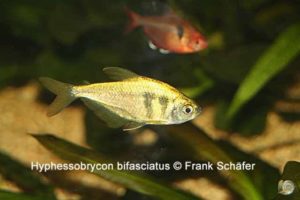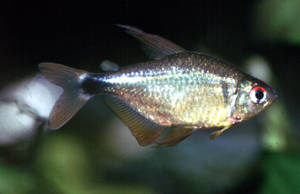It’s amazing how many new, attractive tetra species have been discovered recently! Among them is Hyphessobrycon peugeotorum, which was only scientifically described in 2013 under the name H. peugeoti. It originates from the Brazilian state of Mato Grosso (middle drainage of the Rio Juruena, upper basin of the Rio Tapajós). The unusual species name does […]
Search Results for: Hyphessobrycon
-
-
Hyphessobrycon montagi
With over 130 species, the genus Hyphessobrycon has become very confusing. New species are still being discovered. It has long been known that Hyphessobrycon is an artificial collective genus and that the species in it are not necessarily closely related to each other. For this reason, “groups” have been defined within Hyphessobrycon from time to […]
-
Thorichthys affinis
“The unexpected often happens” says the well-known proverb. That’s what happened to us with Thorichthys affinis. Some time ago we received juveniles of – according to the breeder – Thorichthys meeki, the firemouth cichlid. The 3-4 cm long juveniles didn’t have much to offer in terms of color, but they were extremely harmonious in terms […]
-
Megalamphodus erythrostigmus = Hyphessobrycon erythrostigma
The regrouping of large fish families continues. After the barbs, armored catfish and cichlids, it’s now the turn of the characins. A major revision was published in September 2024, prompting us to retrain once again. Not all tetra species have been included yet, so it will certainly take a few years before the new name […]
-
Hyphessobrycon pulchripinnis
The lemon tetra, Hyphessobrycon pulchripinnis, is one of the most popular aquarium fish of all and can be found in the standard range of pet shops all over the world. As with so many everyday species, little thought is given to them, but the lemon tetra holds many secrets! Its native habitat was unknown until […]
-
Hyphessonbrycon cf. pulchripinnis “Bolivia Orange”
The lemon tetra, Hyphessobrycon pulchripinnis, is one of the most popular aquarium fish of all and can be found in the standard range of pet shops. As with so many everyday species, little thought is given to them, but the lemon tetra holds many secrets! The ancestors of the animals that we can occasionally offer […]
-
Tetragonopterus denticulatus
The genus Tetragonopterus used to be the catch-all for all smaller tetra species, which are now found in the genera Hemigrammus, Hyphessobrycon or Moenkhausia, for example. The English term “tetra” for all tetras, an abbreviation of Tetragonopterus, has survived. Nowadays there are only 14 species of Tetragonopterus, of which only T. argenteus can be considered […]
-
Hyphessobrycon columbianus
Hyphessobrycon columbianus was described by Zarske & Géry in 2001. According to Weitzman, the fish belongs to the “Rosy Tetra group” (in the broadest sense “ornamental tetra relatives”). The first specimens arrived in Germany in 1995, caught in a tributary of the Rio Acanti, Colombia. All specimens currently on the market are said to be […]
-
Hemigrammus filamentosus
In 2010, we were able to import a new tetra from Brazil via Belem for the first time, which could not be clearly assigned to any scientifically described species. It was provisionally named Hyphessobrycon cf. stegemanni and Phoenix tetra. Today we know that the species originates from the Rio Araguaia. The maximum length is 3-4 […]
-
Hyphessobrycon saizi (“Hyphessobrycon eos”) Colombian gold tetra
The most common “gold tetra” in the trade comes from Colombia and is generally traded under a false name. It can be found in the trade up and down the country for little money under the name Hyphessobrycon eos (sometimes also as Hemigrammus eos). The species Hyphessobrycon eos actually exists, but it is not kept […]
-
Hyphessobrycon myrmex
A great aquarium future can be predicted for this new dwarf tetra – it barely reaches a total length of 3 cm – now that breeding has been successful and the initially rather expensive rarity is coming onto the market in large numbers. The brilliance of the colors in this little animal is really quite […]
-
Hyphessobrycon pyrrhonotus JUVENILE
There are three species of the so-called bleeding heart tetras. They all have a pink to cherry-red spot in the middle of the front half of the body. Adult specimens of Hyphessobrycon erythrostigma (upper Amazon, imported from Peru, see https://www.aquariumglaser.de/en/09-characoids-tetra-relationship/hyphessobrycon-erythrostigma-2/), H. socolofi (Rio Negro catchment, Brazil, see https://www.aquariumglaser.de/en/09-characoids-tetra-relationship/hyphessobrycon-socolofi-var-green-2/) and H. pyrrhonotus (also Rio Negro catchment, […]
-
Poecilia salvatoris
The Liberty Molly is an old acquaintance in the aquarium, but until recently it was considered to be a mere variant and synonym of the common Central American shortfin molly (Poecilia sphenops). Only in recent years have efforts been made to shed light on the darkness that makes the systematic classification of these fish so […]
-
Hemigrammus rubrostriatus
In the past, we were only able to present this beautiful tetra, which was only scientifically described in 2015, as a rare by-catch (e.g. https://www.aquariumglaser.de/en/09-characoids-tetra-relationship/hemigrammus-rubrostriatus/). However, we are now able to import these beautiful fish from Venezuela on a regular basis, as we have done again recently. The approximately 4-5 cm long animals are fully […]
-
Hyphessobrycon epicharis (2)
We recently succeeded in importing the species Hyphessobrycon epicharis, which had previously only been imported in very small numbers (see https://www.aquariumglaser.de/en/09-characoids-tetra-relationship/hyphessobrycon-epicharis-2/ and https://www.youtube.com/watch?v=RBofRyOLk3g). Now we have succeeded in importing once more that species that is unmistakable due to its distinctive shoulder spot. This time the animals are somewhat smaller (and therefore cheaper), but more colorful. […]
-
Dieter Bork (1945 – 2023)
When the news reached us last Wednesday, 27.9.2023, that Dieter Bork had died, it was a shock. We had just met in the fish hall of Aquarium Glaser, he was as lively as ever, full of plans and ideas, anything but frail. It still seems inconceivable to me that he will never again tell us […]
-
Hyphessobrycon rosaceus (“ornatus”)
In 1997, the US ichthyologists Stanley Weitzman and Lisa Palmer published a scientific paper that caused a sensation among experts. In it, they described the new species Hyphessobrycon epicharis, but also commented in detail on a relationship group within the South American small tetras known as the “rosy tetra clade”. The authors showed, among other […]
-
Hyphessobrycon haraldschultzi
After a long time we could finally import some of the beautiful Hyphessobrycon haraldschultzi from the Rio Araguaia in Brazil. The animals are clearly slimmer than serpa tetras (H. eques, “serpae”, “minor” etc.). The coloration is more reminiscent of H. amandae, because the red is – unlike serpa tetras – not a rich blood red […]
-
Hyphessobrycon pyrrhonotus
The handsome red-backed bleeding heart tetra of the bleeding heart tetra group (three scientifically known species to date) is the most recently discovered, and was only described by Burgess in 1993. The males having elongated dorsal fins and a very handsome and conspicuous red dorsal, less pronounced also the females. A successful breeding has not […]
-
Hyphessobrycon erythrostigma
The “Peru Bleeding Heart” (Hyphessobrycon erythrostigma) is exported primarily from Peru, but is quite widely distributed in the upper Amazon and is also found in Brazil, Ecuador, and Colombia. The three species of bleeding hearts are closely related and look very similar. H. pyrrhonotus is the easiest to recognize because it has a blood red stripe […]
-
Hyphessobrycon jackrobertsi
Already since 1958 a tetra from Peru enjoys great popularity among aquarists under the fantasy name “Hyphessobrycon robertsi”. The males like to impress each other with their enormously extended dorsal fins, which led to the German common name “Sichelsalmler” (= sickle tetra). However, the species was not scientifically named for a long time. In a […]
-
Hyphessobrycon epicharis
Since the first scientific description of Hyphessobrycon epicharis in 1997, this species is on the dream list of many tetra enthusiasts. Unique feature of this Rosy tetra is the shape of the shoulder spot, which distinguishes it from all other species. The specimens on which the first description was based came from the upper reaches […]
-
Gymnocorymbus bondi (formerly: G. socolofi)
It has been a long time since we could import the last time the beautiful tetra Gymnocorymbus bondi from Colombia. Very small animals remind strikingly of the Yellow Tetra (Hyphessobrycon bifasciatus), but with increasing growth the shape changes more and more to the one known from Gymnocorymbus. Now we finally got this orangefin tetra once […]
-
Hyphessobrycon micropterus
Again we succeeded in importing the unfortunately very rarely offered, very attractive Hyphessobrycon micropterus from the Rio Sao Francisco in Brazil. For more information please see: https://www.aquariumglaser.de/en/fish-archives/hyphessobrycon-micropterus-2/ The pictures in this post show animals from our current stock (June 2022). For our customers: the animals have code 261853 on our stock list. Please note that […]
-
Hyphessobrycon socolofi var. Green
Only rather rarely – every few years – and if, then always in the summer months June-July-August, we receive Hyphessobrycon socolofi from Brazil, in which the back shines conspicuously green; besides, the second cherry-red spot on the tail root is colored particularly intensively red with these animals. We have been observing this phenomenon for many […]
-
Hyphessobrycon sp. aff. bifasciatus “Ghost” and H. bifasciatus “Red Fin” wild
For the first time we can offer this interesting and attractive tetra novelty: Hyphessobrycon sp. aff. bifasciatus “Ghost”. The origin of this fish is not known to us. Our breeder received the parents from Vienna. When the young fish obtained with them developed strong red fins, which they lost again when growing up, the close […]
-
Hyphessobrycon takasei
The Coffee Bean Tetra is an exceptional species within the so-called Rosy Tetras: no other species has even a hint of such a large shoulder spot. The distribution area of the species is in the lower Amazon basin, the border area between Brazil and French Guyana. There you can find the Coffee Bean Tetra in […]
-
Hyphessobrycon cyanotaenia – extra pretty wild catches
The tetra Hyphessobrycon cyanotaenia was originally imported as “Lapis-Tetra” from Brazil; that was more than 20 years ago (see https://www.aquariumglaser.de/en/?s=cyanotaenia). Since the breeding was successful this beautiful and easy to keep fish is now a common sight in the trade. The origin was mysterious for a long time, because the scientific description was based on […]
-
Hyphessobrycon procyon
One of the still very expensive tetra novelties in the aquarium is the very, very pretty Hyphessobrycon procyon from the Rio Aripuanã in the middle basin of the Rio Madeira. It looks confusingly similar to the kitty tetra, H. heliacus, at first glance. H. procyon and H. heliacus form a species complex together with the […]
-
Hyphessobrycon notidanos “Red Devil
Hyphessobrycon notidanos from the upper drainage of the Rio Tapajós in Brazil, which was scientifically described only in 2006, is apparently a quite multicolored animal. So there is the “Red Devil” with much red in the body and blue iris and the “Yellow Devil” with red iris. Both color forms are said to occur together […]
-
Hyphessobrycon negodagua
At present the small tetras of South America experience a new boom. Numerous species have been and are being described scientifically. Thus also the ornamental fish collectors leave their beaten tracks and look for these animals, particularly since currently peppered prices are paid for the novelties. Naturally, such a thing only works for a short […]
-
Hyphessobrycon melanostichos
At the moment we can offer magnificent, fully grown bred specimens of Hyphessobrycon melanostichos. Hyphessobrycon melanostichos is very eye-catching due to its bright sky-blue back coloration. The species was scientifically described in 2006 from the Brazilian state of Mato Grosso, where it occurs in the upper drainage of the Rio Tapajós. The species is distinguished […]
-
Hyphessobrycon dorsalis
Tetras, which – as Hans-Georg Evers so aptly put it – are magnificently white wine colored, have a hard time in aquarists. In the dealer’s tank there is usually nothing to be seen of the discreet colors and why, many ask, should one buy colorless fish when there are so many colorful species? This opinion […]
-
The global ornamental fish trade in times of Corona
The ornamental fish industry, as an international, global player, is naturally particularly affected by the pandemic; however, it is not only the virus and its direct effects that are causing problems for breeders, catchers and exporters around the world. Climatic changes, industrial conversion of the landscape, water pollution and social aspects also have a major […]
-
Hyphessobrycon moniliger
Under the name “Hasemania hansseni” a new tetra has recently appeared on the market, which with its intense orange coloration is indeed somewhat reminiscent of the well-known copper tetra, Hasamania nana. However, one of the characteristics of the genus Hasemania is that it lacks the adipose fin that is so typical for tetras. This is […]
-
Hyphessobrycon moniliger
Under the name “Hasemania hansseni” a new tetra has recently appeared on the market, which with its intense orange coloration is indeed somewhat reminiscent of the well-known copper tetra, Hasemania nana. However, one of the characteristics of the genus Hasemania is that it lacks the adipose fin that is so typical for tetras. This is […]
-
Hyphessobrycon sp. “Muzel Red Cherry“
From Brazil we received this really nice novelty, which looks a bit like an enlarged edition of the Ember tetra, Hyphessobrycon amandae. However has the “Muzel Red Cherry” two (although indistinct) shoulder spots, which never occurs in H. amandae. In addition, the dorsal fin in “Muzel Red Cherry” is red with a light margin, while […]
-
Hyphessobrycon eques “Longfin”
The Serpa Tetra, also called the Callistus Tetra (Hyphessobrycon eques, formerly known as H. callistus or H. serpae), is the little man’s piranha. Just like piranhas, serpa tetras have an irresistible urge to bite the fins of other fish. And they constantly want to test out who is the stronger. This makes many exciting observations […]
-
Psalidodon anisitsi (= Hyphessobrycon a., Hemigrammus caudovittatus)
One of the oldest aquarium fishes is the Buenos Aires tetra, of which the correct scientific name was only recently determined: Psalidodon anisitsi. To most aquarists, however, the species is probably still known as Hemigrammus caudovittatus (or Hyphessobrycon anisitsi), and it is under this name that it is found in most aquarium books. Since its […]
-
Hyphessobrycon micropterus
In 1915 the scientist Carl Eigenmann described a new tetra genus, which he named Megalamphodus. Type species is M. megalopterus, an aquaristic very well known species: the Black Phantom Tetra. In 1997 Megalamphodus became a synonym of Hyphessobrycon. Of the remaining species assigned to Megalamphodus in 1915 (ecuadoriensis, eques, heteresthes, melanotus, micropterus), only the Serpae […]
-
Hyphessobrycon heterorhabdus
Already in 1894 the three-banded flag tetra (Hyphessobrycon heterorhabdus) was described scientifically; the animals on which the description was based came from the Brazilian state of Pará, more detailed information or illustrations are not available. From 1910 and in the 1920s, when the tetras advanced to the most popular aquarium fishes, also three-banded tetras came […]
-
Hyphessobrycon “ornatus White Fin” XL
We just have a tank full of fully grown rosy tetra (Hyphessobrycon rosaceus) of the breeding form “White Fin” in stock. These magnificent fish are a real feast for the eyes. Read more about this form of fish, which is also known as H. bentosi or H. ornatus in the hobby here: https://www.aquariumglaser.de/en/fish-archives/hyphessobrycon-ornatus-white-fin-2/ For our […]
-
Moenkhausia hemigrammoides
From Venezuela we recently received „feather tetras“. This is what we used to call tetras that have a striking black stripe in the anal fin, accompanied by a white line in front of it. In general, however, the term “feather tetra” is alternatively used to species of the genus Hemiodus or Hyphessobrycon copelandi. Our “feather […]
-
Hyphessobrycon hexastichos
This pretty tetra is a double of the very similarly colored species Moenkhausia agnesae. It remains however with 5,5 cm length smaller than M. agnesae, which becomes nearly 7 cm long. In addition, H. hexastichos, which occurs exclusively in the upper catchment area of the Rio Tapajós in Brazil, is not as quarrelsome as M. […]
-
Moenkhausia simulata
We obtained a somewhat irritating import of a very rare species of tetra last week from Peru. In all probability, it is Moenkhausia simulata; however, our new import differs slightly from the previously known M. simulata in coloration. All other tetra species with a pattern of several horizontal stripes (Astyanax lineatus, A. kullanderi, A. superbus, […]
-
Hyphessobrycon peruvianus
Three species of tetra in northern South America are obviously close relatives to each other and often confused: Hyphessobrycon loretoensis from Peru, H. metae from Colombia, and H. peruvianus, again from Peru. From these, H. loretoensis has been portayed here: http://www.aquariumglaser.de/en/hyphessobrycon-loretoensis_de_1188.html. Currently we were able to import the second Peruvian species once more, H. peruvianus, […]
-
Hyphessobrycon “ornatus White Fin”
Among he longest-serving rosy tetras in the hobby is Hyphessobrycon ornatus, even if the species has a true odyssey concerning the naming behind it and is called Hyphessobrycon rosaceus according to the latest state of affairs; before it was equated with H. bentosi. The first specimens arrived already in 1933 from Guyana. Breeding was not […]
-
Hyphessobrycon herbertaxelrodi „Smoke“
This is a very interesting and beautiful new sport of tetra. One can only guess that it belongs to the species Hyphessobrycon herbertaxelrodi, but there is no other species known in the hobby that fits better. Two characters make this fish very desirable: the extraordinary strong schooling behaviour and the intensive dark coloration of the […]
-
Tetragonopterus argenteus
Currently we can offer wonderful, fully grown Tetragonopterus argenteus from Paraguay. The species attains a length of 8 – 12 cm. Formerly the genus Tetragonopterus was a catch-all genus for small characins from South America. Most of them are placed now in other genera, for example Hemigrammus, Hyphessobrycon, or Moenkhausia. But still the common name […]
-
Hyphessobrycon piranga
Currently we can offer exclusively some top-rarities among the tetra family, all German bred. One of them is Hyphessobrycon piranga, which was introduced in the hobby by Peter and Martin Hoffmann in the German magazine Datz (issue 11/2017) under the unusual name of „Hyphessobrycon sp. non-red devil“. Despite the fact that the new tetra has […]
-
Hyphessobrycon elachys
Among the smallest species of tetra is Hyphessobrycon elachys, the veilfin tetra from Paraguay. The species becomes only 1.5-2 cm long (standard length without caudal fin). The charming animals inhabit swampy areas in the Rio Paraguay drainage. The genus Hyphessobrycon, as it is currently defined, represents an artifical assamblage of species which are not very […]
-
Hyphessobrycon paepkei
The Goldshoulder rosy tetra, Hyphessobrycon paepkei, has been described only a few years ago, the type specimens originated from our fishhouse. THe natural distribution is in the Rio Negro in Brazil. Usullay onyl a few specimens could be selected from shipments of other species, but now we are able to offer the beautiful Goldshoulder rosy […]
-
Hyphessobrycon wadai
We are very glad to be able to offer this beautiful tetra for the first time now. The fish are German bred ones. The species has been described only in 2016. The natural distribution is the upper basin of the Rio Tapajós. This tetra is already a popular aquarium fish in Sao Paulo (Brazil) since […]
-
Hyphessobrycon flammeus GOLD
We want to remind on one of the first species of tetra that reached us from the area around Rio de Janeiro: Hyphessobrycon flammeus, the Flame Tetra. Since the first importation in the year 1924 the species is present in aquaria all over the world, for the fish are easy to breed and very productive. […]
-
Hyphessobrycon eques wild
The Serpae tetra is one of the most popular tetras at all. This is doubtless due to its intensive red coloration. In respect of the behaviour one cannot trust them too far. They have the nasty tendency to bite off pieces of finnage from other fish, also from conspecifics. From a scientific point of view […]
-
Nannostomus trifasciatus „Gold“
Only very rarely we obtain assorted „goldtetras“ in numbers. An exception of that rule is, however, „the“ gold tetra, Hyphessobrycon saizi (usually traded under the wrong name H. eos). But basically every tetra can become a golden one – they are only hard to find. We now received from Peru large, fully mature golden Nannostomus […]
-
Hyphessobrycon cf. agulha Red Tail
We received a new species of tetra in number which reached us in former times in single specimens only from the Rio Negro region. Without any doubts the animals are identical with the tetra illustrated on page 472 of „the bible of tetra lovers“, Gery´s „Characoids of the world“. The caption says „Hyphessobrycon agulha, or […]
-
Hyphessobrycon eques wild
The Serpae tetra is one of the most popular tetras at all. This is doubtless due to its intensive red coloration. In respect of the behaviour one cannot trust them too far. They have the nasty tendency to bite off pieces of finnage from other fish, also from conspecifics. From a scientific point of […]
-
Hyphessobrycon herbertaxelrodi Wild
Wild collected black neon tetra? This is extremely rare, even in our company. The black neon tetra is one of the most often traded ornamental fish at all and much sought for. So it is available any time in any number as bred ones, even some artifical sports have been bred, like „smoke“ or „albino“. […]
-
Two new tetras from the Rio Negro region: Hyphessobrycon paepkei and H. cf. agulha
In a shipment containing Hyphessobrycon socolofi (Socolof´s bleeding heart) we found an extraordinary large number of bycatches. Allmost half of the shipment were another species, obviously a close relative of H. ornatus (Rosy tetra). We took a closer look and found the the bycatches were the Goldshoulder rosy tetra, H. paepkei. This species has been […]
-
Hyphessobrycon melanostichos
In our latest newsletter I made a regattable mistake: I used pictures of Hyphessobrycon cf. melanostichos instead of pictures of the „real“ Hyphessobrycon melanostichos in the post; H. cf. melanostichos differs a lot from the „real“ species in life colours. So here are now pictures of the „real“ H. melanostichos, the fish we currently have […]
-
Hyphessobrycon sp. Red-Blue Peru Tetra, now H. margitae
This tetra, which attains a maximum length of about 4-5 cm, is without any doubts one of the most attractive members of the tetra family. The species has been described scientifically recently under the name of Hyphessobrycon margitae. It originates from Peru, according to the exporters from the Loreto region, Rio Nanay basin. Regarding the […]
-
Hemigrammus rubrostriatus
Until now we were able to present this beautiful tetra – which has been described scientifically only in 2015 – to you only as a very rare bycatch (see http://www.aquariumglaser.de/en/fish-archives/hemigrammus-rubrostriatus/). But finally we managed a larger importation of that beauty from Venezuela. The fish are about 4-5 cm longer, adult and in full colour. They […]
-
Hemigrammus rubrostriatus
Recently we obtained two specimens of a small tetra as a sample from Peru. The supplier asked us for the determination of the species. The animals looked somewhat familiar to us. Didn´t we get such fish not from Colombia formerly? A short e-mail correspondence with the tetra expert Martin Hoffmann solved the riddle: this species […]
-
Hyphessobrycon dorsalis (formerly determined as H. minor)
The scientific description of a new species bases usually on dead specimens that are stored in a museum. Very often it is unknown how the living organism looks. Especially in small species of freshwater fish – the animals most often kept in aquaria – this method very often leads to mis-identifications, for the preserved specimens […]
-
Hyphessobrycon copelandi
This tetra is the most gracile of the so called „rosy tetras“. The rosy tetras are a specious clade of tetras that share the following characters: a comparatively deep body, a humeral spot (the spot on the shoulder), long fins in males and in females an obvious white-black-white marking in the dorsal fin. The phantom […]
-
Red Phantom Tetra: wild and bred ones
The Red Phantom tetra (Hyphessobrycon, formerly Megalamphodus, sweglesi) is a very popular aquarium fish. Only recently we could present to you the bred albino sport (http://www.aquariumglaser.de/en/news/Megalamphodus_sweglesi_Albino_en/) and the wild variety “rubra” (http://www.aquariumglaser.de/en/fish-archive/tetras-en/hyphessobrycon-hemigrammus-moenkhausia-en/Megalamphodus_en/). The beautiful tetra is available wild collected from Colombia and as bred ones (see http://www.aquariumglaser.de/en/fish-archive/tetras-en/hyphessobrycon-hemigrammus-moenkhausia-en/Red_Phantom_tetra_Hyphessobrycon_sweglesi_en/). In respect of coloration both do not differ […]
-
Hyphessobrycon vilmae
The “chocolate neon tetra”, Hyphessobrycon vilmae, originates from the upper reaches of the Rio Tapajós in Brazil. Sadly it only rarely available. Regarding keeping not much is to say here: the fish requires the very same conditions as the well known “black neon tetra”, Hyphessobrycon herbertaxelrodi. The males of H. vilmae have a more intensive […]
-
Gymnocorymbus socolofi
It´s been quite a long time that we were able to import this pretty tetra – Gymnocorymbus socolofi – from Colombia. Very small specimens look very much alike the Yellow Tetra (Hyphessobrycon bifasciatus), but the larger they grow the more the shape of the body becomes alike a Gymnocorymbus. Finally we received the pretty orange […]
-
The robertsi-tetra has a valid name now
Since 1958 a beautiful and popular tetra from Peru is trade under the name of “Hyphessobrycon robertsi”. However, this name is a pure invention and never ever a scientific description for the tetra appeared. In a scientific study on the relationship of the “rosy tetras” to which the robertsi-tetra belongs, Stanley Weitzman and Lisa Palmer […]
-
The Flame tetra
We take the current FIFA-football World Cup in Brazil as an opportunity to remind on one of the first species of tetra that reached us from the area around Rio de Janeiro: Hyphessobrycon flammeus, the Flame Tetra. Since the first importation in the year 1924 the species is present in aquaria all over the world, […]
-
Hyphessobrycon eschwartzae (= Hyphessobrycon cf agulha)
Finally we were able to import agin this very pretty, only occasionally available tetra from Peru. Keeping this fish is comparable o the popular Black Neon (Hyphessobrycon herbertaxelrodi) that looks also a bit similar. For further information’s, please see http://www.aquariumglaser.de/en/news/Hyphessobrycon_eschwartzae_Hyphessobrycon_cf_agulha__en/ For our customers: the fish have code 260203 on our stocklist. Please note that wee […]
-
Hyphessobrycon sp. aff. metae
We received this beautiful tetra fro Venezuela. So far we were not able yet to determine it exactly. For our customers: the fish has code 261352 on our stocklist. Please note the we exclusively supply the wholesale trade. Text & photos: Frank Schäfer
-
Hyphessobrycon axelrodi
Initially, this charming dwarf tetra was described from the island of Trinidad. The maximum length is 2 cm in males and about 3 cm in females. Now we received a shipment with wild collected specimens from Venezuela. The beautiful animals fit quite good to the description of H. axelrodi, the calypsotetra; the scientist Taphorn determined […]
-
Megalamphodus megalopterus
Black Phantom Tetra The Black Phantom Tetra belongs to the most common species of fish in the aquarium trade. It originates from the Mato Grosso in Brazil, but all fish in the hobby are bred ones. Wild collected specimens do not appear in the trade, because decades of selective breeding produced so pretty fish that […]
-
Hyphessobrycon sp. aff. metae
We could import this pretty tetra from Venezuela. There is no doubt that it represents a close relative of Hyphessobrycon metae. The broad stripe in the caudal fin of our fish is the main difference. For our customers: the animals have code 261352 on our stocklist. Please note that we exclusively supply the wholesale trade. […]
-
Hyphessobrycon heliacus
We currently have magnificent, large bred specimens of the Kitty tetra in stock. The males already have wonderfully developed dorsal fin “flags”. This species has been confused in the past with Hyphessobrycon lowae, which is a different species. For our customers: the animals have code 261334 on our stocklist. Please note that we exclusively supply […]
-
Hyphessobrycon cf. melanostichos
For the first time ever we can offer this attractive new tetra. Our specimens are German bred ones. Hyphessobrycon melanostichos has been described scientifically only in 2006. Until now the fish is known only from the upper reaches of the Rio Tapajos, namely a small river called Rio Doze de Outubro. If our fish are […]
-
Hyphessobrycon eschwartzae (= Hyphessobrycon cf. agulha)
The Flag Tetra (Hyphessobrycon heterorhabdus) belongs to most beautiful small tetras of Amazonia. A sister species, H. amapaensis, occurs in Brazil. It has a similar coloration, but can be recognized by the broad, red stripe. Both species are much sought after. Now we were able to import another species of Flag Tetra from Peru, which […]
-
Hyphessobrycon pulchripinnis ORANGE BOLIVIA
For our customers: the fish have code 261634 on our stocklist. Please note that we exclusively supply the wholesale trade. Photo: Frank Schäfer
-
Hyphessobrycon heliacus
We currently have magnificent, large bred specimens of the Kitty tetra in stock. The males already have wonderfully developed dorsal fin “flags”. For our customers: the animals have code 261333 on our stocklist. Please note that we exclusively supply the wholesale trade. Text & photos: Frank Schäfer
-
Fantastic tetras: German bred!
We received this week German bred Moenkhausia cosmops and Hyphessobrycon haraldschultzi. These fish are very strong, healthy and have brilliant colours. Of course we have only limited quantities of these rare fish available… Read more about the species under http://www.aquariumglaser.de/en/news/Moenkhausia_cosmops_en/ (Moenkhausia cosmops) and http://www.aquariumglaser.de/en/fish-archive/tetras-en/hyphessobrycon-hemigrammus-moenkhausia-en/Hyphessobrycon_haraldschultzi_spec_Araguaia__en/ (H. haraldschultzi). For our customers: M. cosmops has code 268644, H. […]
-
Hyphessobrycon itaparicensis
Code: 261203
-
Hyphessobrycon luetkeni
Code: 259823
-
Hyphessobrycon eschwartzae (= Hyphessobrycon cf. agulha JURUA / PERU)
For the first time ever we were able now to import this beautiful tetra from Peru. Scientifically H. agulha is known for quite a long time, but it has never become an aquarium fish so far. In Jaques Géry´s classical work on Characoids of the World even a complete group of Hyphessobrycon is named after […]
-
Hyphessobrycon cf. pando PERU
Recently we received beautiful Rosy tetras under the name of “Hyphessobrycon robertsi” from Peru. However, the fish is not identical with the well known “robertsi” (the species has not been described formally by a scientist yet, but it is unknown whether is has been made available “by chance” in the past 60 years of its […]
-
Megalamphodus
Honestly speaking, the trade name for this cute fish is completely wrong: first of all, the genus name Megalamphodus is regarded nowadays as a synonym to Hyphessobrycon and twice the species in question is an undescribed one and not identical with the red phantom tetra, H. sweglesi. However, even undescribed fish have to be named […]
-
Hyphessobrycon loretoensis
Some species of ornamental fish live in a kind of shadowy existence. Basically speaking they are always available, beautiful and ideal aquarium fish, but it seems that nobody keeps them actually. One of those species is Hyphessobrycon loretoensis. The tiny tetra (maximum length around 3.5 cm) has been imported as an ornamental fish in 1938, […]
-
A fantastic lemon tetra
The lemon tetra, Hyphessobrycon pulchripinnis, belongs to the most important ornamental fishes and can be found in almost any pet shop. Like in so many other very common species no one gives a thought on them. But even the lemon tetra keeps a lot of secrets….. The origin of the lemon tetra was not known […]
-
Hyphessobrycon amapaensis
One of the most beautiful tetras of South America is availble now in brillantly colored wild collected specimens. The Amapa tetra is an uncomparable eye-catcher for any well suited community tank for South American fishes. As usual, among these wild collected fishes were also specimens of other species, so-called by-catches. This gives us a good […]
-
Hyphessobrycon pyrrhonotus Gold
(Nov.10th 2008) The so called „gold dust disease“ of the bloodfins is a very interesting phenomenon, which happens to very many bloodfin species. The best known one surely is the gold-tetra, Hemigrammus rodwayi whose number of gold-dust-sick animals in nature is higher than of the normal coloured ones. The gold-dust-sick animals were even considered as […]
-
Hyphessobrycon cyanotaenia, Lapis-Tetra
This tetra was introduced to us under the name of “Inpaichthys sp. Lapislazuli” in February 2002 by Mrs. Glaser-Dreyer (Aquarium Glaser GmbH). On the (Japanese) internet it is called Lapis tetra. It was imported in a bigger number of pieces without exact declaration of place of discovery. The males are growing up to at least […]
-
Hyphessobrycon flammeus
The Flame Tetra, Fire Tetra, or Von Rio Tetra is a well established aquarium guest. Its origin is the proximity of Rio de Janeiro in Eastern Brazil, where it occurs in coastal rivers. As swarm fishes they need the society of conspecifics. Since the optical impression of the observer depends on the swarm size, it […]
-
Hyphessobrycon haraldschultzi (= spec. „Araguaia“)
Red fish always attract interest amongst hobbyists, especially the intensively red coloured ones. Five years ago when we received the first animals of this tetra by the name of “Hyphessobrycon serpae – the real one” (wildcaught from Rio Araguaia), we were immediately enthusiastic, too. At first sight (still inside the transport bag) these tetras looked […]
-
Hyphessobrycon agulha
This very attractive Tetra originates from the Rio Madeira, which runs into the Amazon River downstream from Manaus in Brazil. This Characin species will probably not grow much larger then 6 cm. They are friendly and lively schooling fish, very suitable for a community tank. These fish are not difficult in keeping and will tolerate […]
-
Red Phantom tetra, Hyphessobrycon sweglesi
Until a few years ago Red Phantom tetra, Hyphessobrycon sweglesi was easy to identify, even though under the name of Megalamphodus sweglesi. Lately “Red Phantom Tetras” appear more often, which are very similar to it, but also show other characteristics. It stays (temporarily) unclear, if they are own species, subspecies or “local forms”. Interested hobbyists, […]
-
Hyphessobrycon bifasciatus
The Yellow Tetra originates like its close related Von Rio Tetra from coastal rivers in southeast Brazil. With its pretty yellow basic colour it forms a beautiful contrast to it and other reddish characin species. As a schooling fish the Yellow Tetra should be kept only in larger swarms. Particularly in not too brightly lit […]
-
Hyphessobrycon cf. loweae
It was illustrated on the homepage of Canadian fish exporter “Below Water” and designated as “Kitty” Tetra (“a new Hemigrammus-species, caught in Mato Grosso in November 2000). It is presented as Hyphessobrycon loweae in the February/March-issue of “Aquaristik Fachmagazin & Aquarium heute”. According to Dr. Géry there are “good correspondences” with Hyphessobrycon loweae (Costa & […]





